19 Fascinating Photos Collected From History
Nathan Johnson
Published
06/14/2017
in
wow
history is fascinating
- List View
- Player View
- Grid View
Advertisement
-
1.
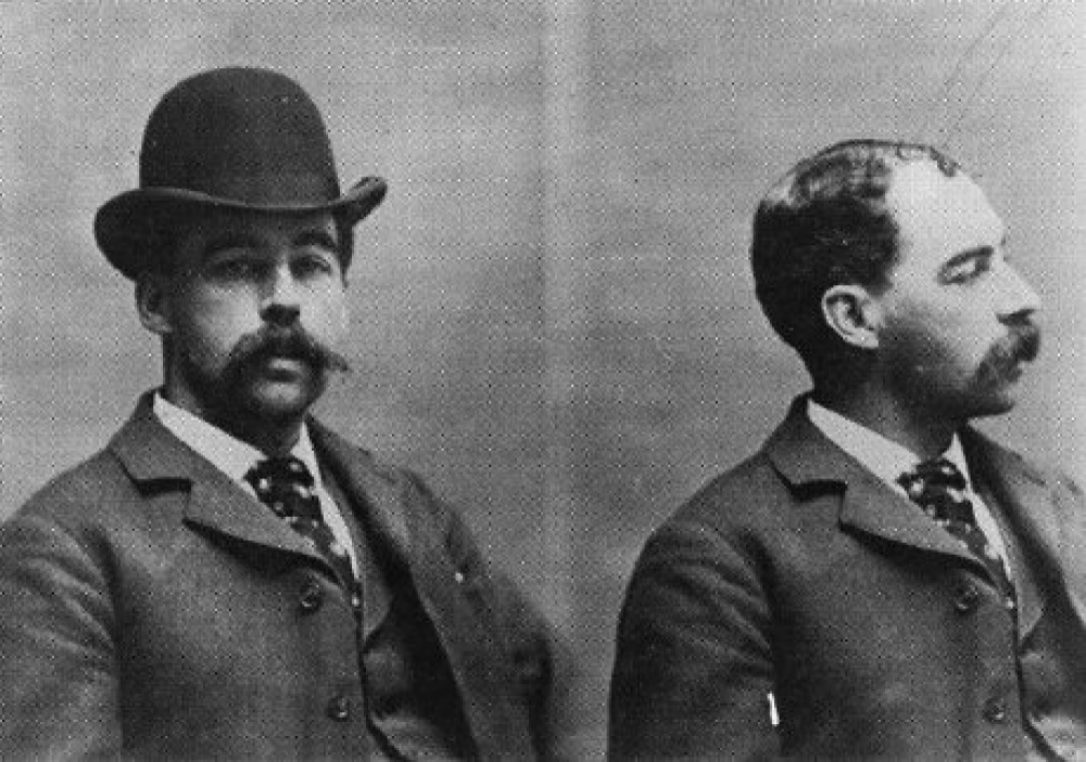 H.H. Holmes The First Serial Killer Of America. Dr. Henry Howard Holmes was America’s first documented serial killer. As his famous controversial story goes, Holmes opened a hotel in Chicago which he design himself to situate his plans of murder. He has been proven guilty for almost 200 murders in the US. On his trial, he spoke out a chilling statement that goes: “I was born with the devil in me. I could not help the fact that I was a murderer, no more than the poet can help the inspiration to sing — I was born with the ‘Evil One’ standing as my sponsor beside the bed where I was ushered into the world, and he has been with me since.”
H.H. Holmes The First Serial Killer Of America. Dr. Henry Howard Holmes was America’s first documented serial killer. As his famous controversial story goes, Holmes opened a hotel in Chicago which he design himself to situate his plans of murder. He has been proven guilty for almost 200 murders in the US. On his trial, he spoke out a chilling statement that goes: “I was born with the devil in me. I could not help the fact that I was a murderer, no more than the poet can help the inspiration to sing — I was born with the ‘Evil One’ standing as my sponsor beside the bed where I was ushered into the world, and he has been with me since.” -
2.
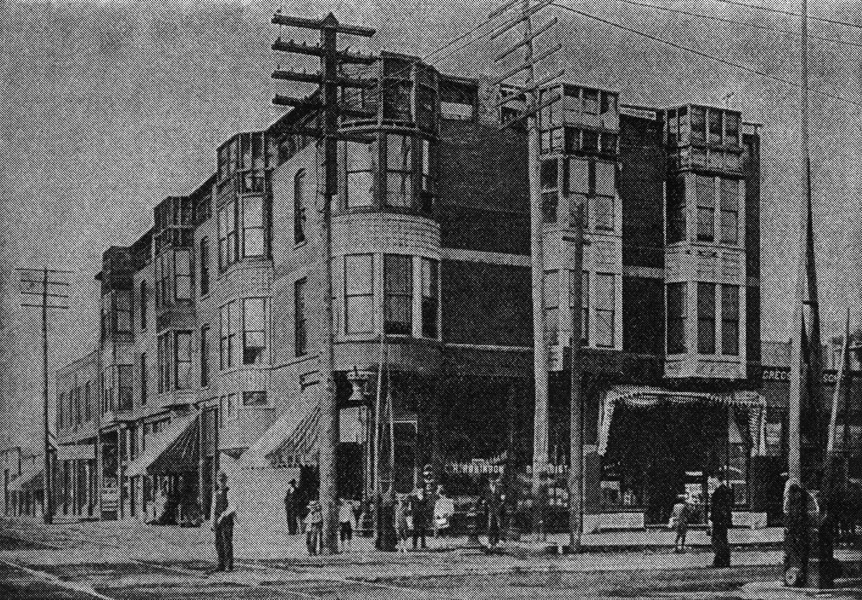 The murder castle of H.H. Holmes. In 1886, H.H. Holmes, a pharmacist who would later be called the first U.S. serial killer, bought a Chicago drugstore that was owned by a cancer-stricken man named E.S. Holton. When Holton died, Holmes bought up surrounding property until he’d acquired an entire city block. He renovated the buildings and turned them into a hotel just in time for the 1893 World’s Fair. But this was no ordinary hotel: most of the rooms were windowless, with stairways to nowhere and hallways that ended in dead ends. Holmes also built gas jets into hotel-room walls, a wooden disposal chute and person-size kiln in the basement. This was the perfect place to murder someone. And that’s exactly what Holmes did: for much of 1893, he tortured and killed an untold number of people at his hotel, mostly young women visiting the city for the World’s Fair. Holmes was caught and eventually hanged.
The murder castle of H.H. Holmes. In 1886, H.H. Holmes, a pharmacist who would later be called the first U.S. serial killer, bought a Chicago drugstore that was owned by a cancer-stricken man named E.S. Holton. When Holton died, Holmes bought up surrounding property until he’d acquired an entire city block. He renovated the buildings and turned them into a hotel just in time for the 1893 World’s Fair. But this was no ordinary hotel: most of the rooms were windowless, with stairways to nowhere and hallways that ended in dead ends. Holmes also built gas jets into hotel-room walls, a wooden disposal chute and person-size kiln in the basement. This was the perfect place to murder someone. And that’s exactly what Holmes did: for much of 1893, he tortured and killed an untold number of people at his hotel, mostly young women visiting the city for the World’s Fair. Holmes was caught and eventually hanged. -
3.
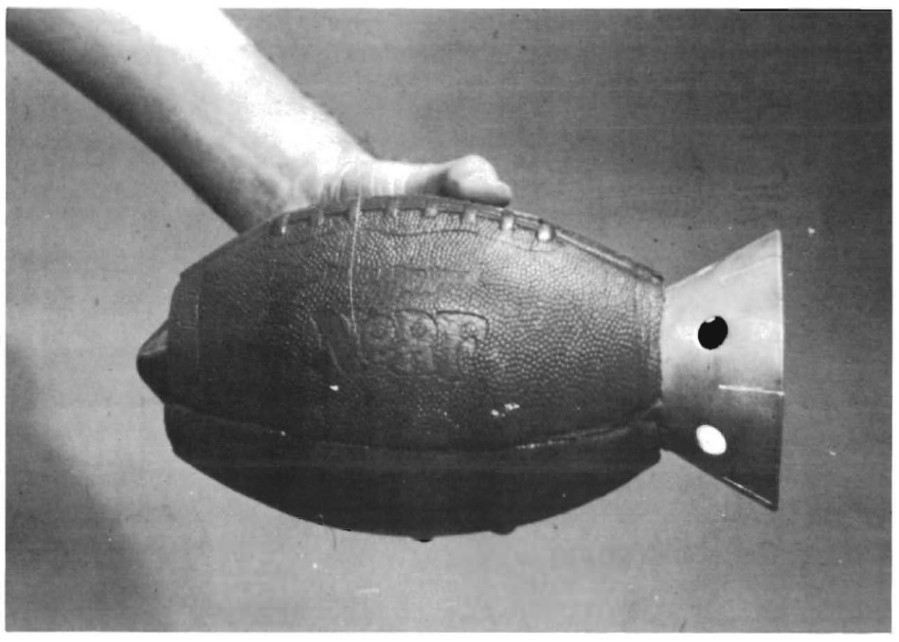 U.S. Army prototype anti-armor hand grenade from 1973 – a shaped charge, packed in a hollowed-out NERF football
U.S. Army prototype anti-armor hand grenade from 1973 – a shaped charge, packed in a hollowed-out NERF football -
4.
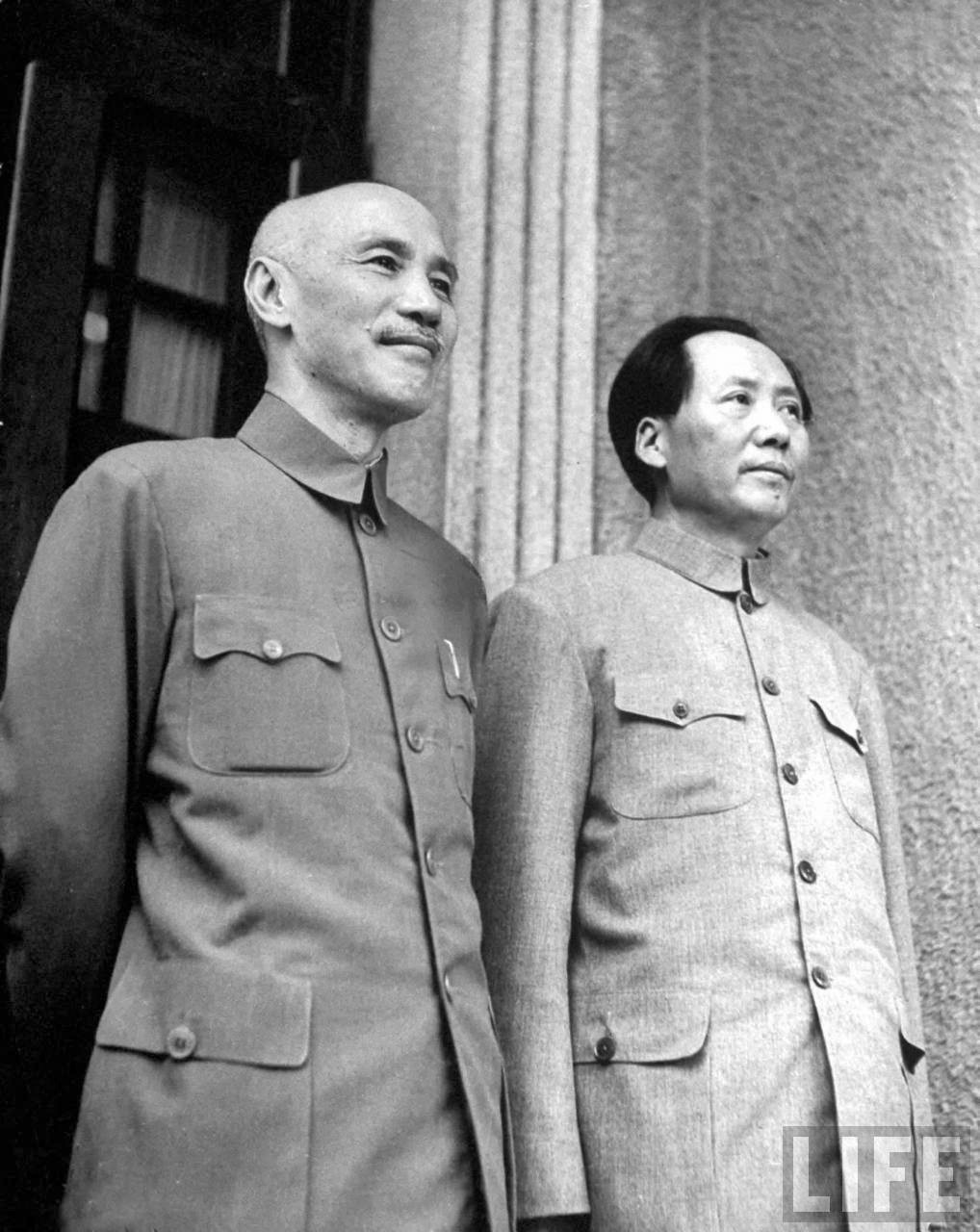 The leader of the Republic of China General Chiang Kai-shek standing next to the leader of the Chinese Communist Party Mao Zedong, 1945. Taken shortly after the end of WW2 during negotiations in Chongqing
The leader of the Republic of China General Chiang Kai-shek standing next to the leader of the Chinese Communist Party Mao Zedong, 1945. Taken shortly after the end of WW2 during negotiations in Chongqing -
5.
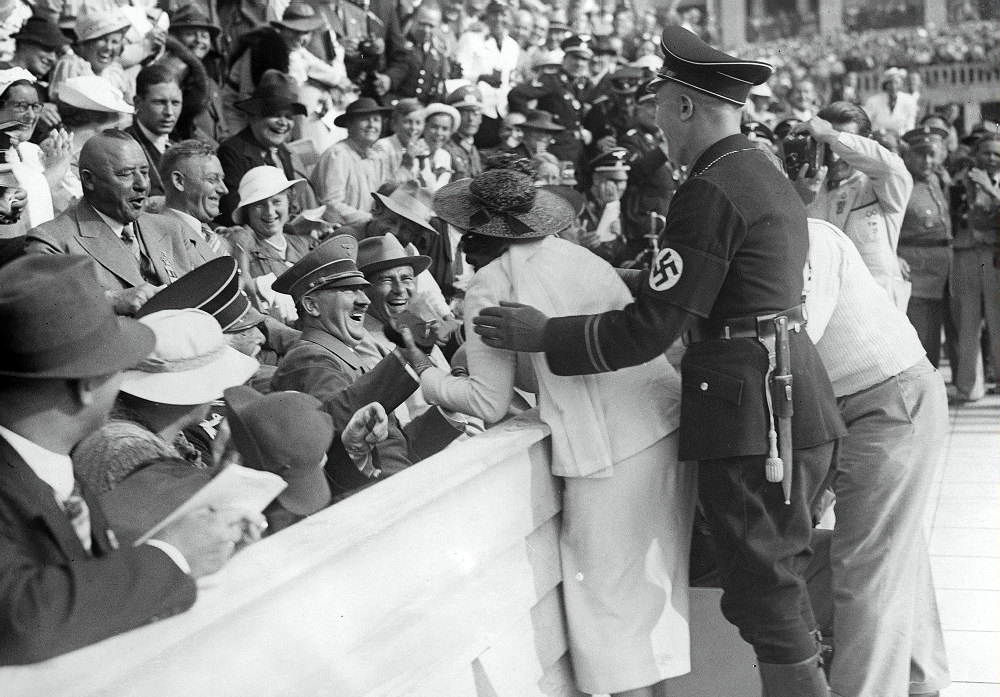 Hitler Reacts to Kiss from Excited American Woman at the Berlin Olympics, August 15, 1936. Shortly before the finish of the men’s 1500 meters free-style swimming, a woman in a red hat, whom Black Guards repeatedly prevented from photographing Hitler at close range, broke the cordon during the excitement of the finish of the race, shook Hitler by the hand and then kissed him, while the crowd of 20,000 rocked with laughter. Hitler, who was in high spirits, joined in the fun, clapping his hands as the woman returned triumphantly to her seat. The woman, Carla De Vries, was a 40-year old American traveling in Europe. Her brother-in-law was quoted in that “She wanted to meet Hitler but I’m surprised at the way she did it”. Her rationale from her own words? “Why? I simply embraced him because he appeared so friendly and gracious. People sitting near Der Fuehrer’s box began to cheer and applaud so loudly that I ran back to my husband and told him we had better leave. I don’t know why I did it. Certainly I hadn’t planned such a thing. It’s just that I’m a woman of impulses, I guess. It happened when I went down to take Hitler’s picture with my small movie camera. Hitler was leaning forward, smiling, and he seemed so friendly that I just stepped up and asked for his autograph, which he wrote on my swimming ticket. He kept on smiling and so I kissed him”. For their failure to halt the woman, several of Hitler’s hulking Schutzstaffel guards were dismissed in disgrace, several more were demoted in rank.
Hitler Reacts to Kiss from Excited American Woman at the Berlin Olympics, August 15, 1936. Shortly before the finish of the men’s 1500 meters free-style swimming, a woman in a red hat, whom Black Guards repeatedly prevented from photographing Hitler at close range, broke the cordon during the excitement of the finish of the race, shook Hitler by the hand and then kissed him, while the crowd of 20,000 rocked with laughter. Hitler, who was in high spirits, joined in the fun, clapping his hands as the woman returned triumphantly to her seat. The woman, Carla De Vries, was a 40-year old American traveling in Europe. Her brother-in-law was quoted in that “She wanted to meet Hitler but I’m surprised at the way she did it”. Her rationale from her own words? “Why? I simply embraced him because he appeared so friendly and gracious. People sitting near Der Fuehrer’s box began to cheer and applaud so loudly that I ran back to my husband and told him we had better leave. I don’t know why I did it. Certainly I hadn’t planned such a thing. It’s just that I’m a woman of impulses, I guess. It happened when I went down to take Hitler’s picture with my small movie camera. Hitler was leaning forward, smiling, and he seemed so friendly that I just stepped up and asked for his autograph, which he wrote on my swimming ticket. He kept on smiling and so I kissed him”. For their failure to halt the woman, several of Hitler’s hulking Schutzstaffel guards were dismissed in disgrace, several more were demoted in rank. -
6.
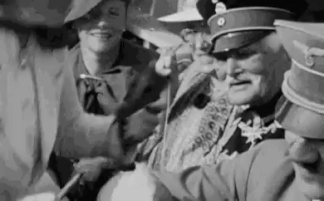
-
7.
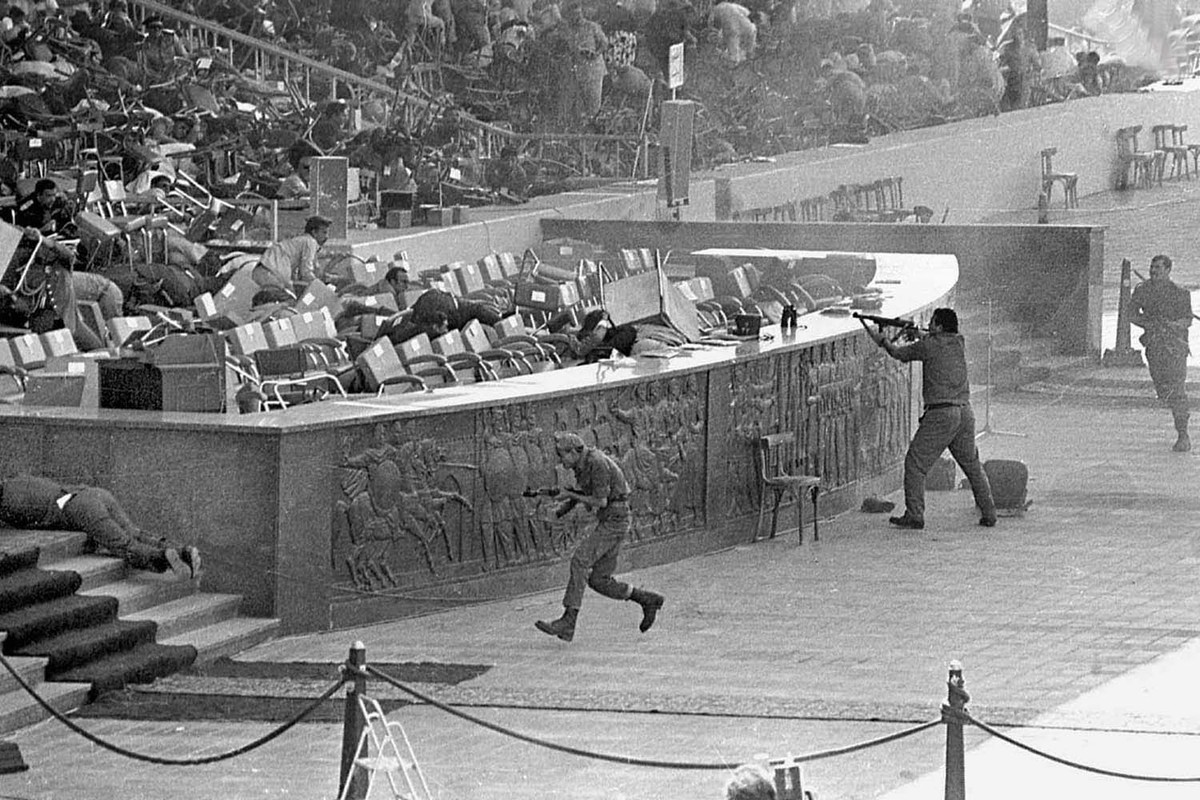 The assassination of Anwar Sadat, 1981. On 6 October 1981, a victory parade was held in Cairo to commemorate the eighth anniversary of Egypt’s crossing of the Suez Canal. Sadat was protected by four layers of security and eight bodyguards, and the army parade should have been safe due to ammunition-seizure rules. As Egyptian Air Force Mirage jets flew overhead, distracting the crowd, Egyptian Army soldiers and troop trucks towing artillery paraded by. One truck contained the assassination squad, led by Lieutenant Khalid Islambouli. As it passed the tribune, Islambouli forced the driver at gunpoint to stop. From there, the assassins dismounted and Islambouli approached Sadat with three hand grenades concealed under his helmet. Sadat stood to receive his salute. Anwar’s nephew Talaat El Sadat later said: “The president thought the killers were part of the show when they approached the stands firing, so he stood saluting them”. Islambouli threw all his grenades at Sadat, only one of which exploded (but fell short), and additional assassins rose from the truck, indiscriminately firing AK-47 assault rifles into the stands until they had exhausted their ammunition and then attempted to flee. After Sadat was hit and fell to the ground, people threw chairs around him to shield him from the hail of bullets.
The assassination of Anwar Sadat, 1981. On 6 October 1981, a victory parade was held in Cairo to commemorate the eighth anniversary of Egypt’s crossing of the Suez Canal. Sadat was protected by four layers of security and eight bodyguards, and the army parade should have been safe due to ammunition-seizure rules. As Egyptian Air Force Mirage jets flew overhead, distracting the crowd, Egyptian Army soldiers and troop trucks towing artillery paraded by. One truck contained the assassination squad, led by Lieutenant Khalid Islambouli. As it passed the tribune, Islambouli forced the driver at gunpoint to stop. From there, the assassins dismounted and Islambouli approached Sadat with three hand grenades concealed under his helmet. Sadat stood to receive his salute. Anwar’s nephew Talaat El Sadat later said: “The president thought the killers were part of the show when they approached the stands firing, so he stood saluting them”. Islambouli threw all his grenades at Sadat, only one of which exploded (but fell short), and additional assassins rose from the truck, indiscriminately firing AK-47 assault rifles into the stands until they had exhausted their ammunition and then attempted to flee. After Sadat was hit and fell to the ground, people threw chairs around him to shield him from the hail of bullets. -
8.
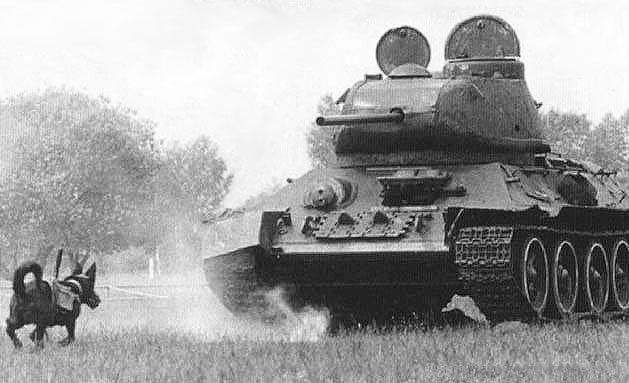 Soviet Exploding Anti-Tank Dog Of WW2. These dogs, usually Alsatians, were also called “Hundminen” or “dog mines.” They were trained to carry explosives on their bodies to enemy tanks, where they would then be detonated. This type of animal weaponry was first used by the Soviets. Following a decision in 1924 to allow dogs to aid the military, a dog training school was set up in Moscow. The military recruited such people as police dog trainers, hunters, circus trainers, and animal scientists. Twelve more schools were set up hot on the heels of the first one and the Soviet dog-training division started out in earnest. At first, dogs were trained to carry supplies, tracking mines, and rescuing people -tasks at which the dogs excelled. In the early 1930s, they decided it would be a good idea to turn man’s best friend into an anti-tank weapon. Three of the schools began training dogs for this purpose. First, they were trained to carry a bomb to a tank and run off; afterwards, their handler could detonate the bomb with a remote or the bomb may have simply been set with a timer.
Soviet Exploding Anti-Tank Dog Of WW2. These dogs, usually Alsatians, were also called “Hundminen” or “dog mines.” They were trained to carry explosives on their bodies to enemy tanks, where they would then be detonated. This type of animal weaponry was first used by the Soviets. Following a decision in 1924 to allow dogs to aid the military, a dog training school was set up in Moscow. The military recruited such people as police dog trainers, hunters, circus trainers, and animal scientists. Twelve more schools were set up hot on the heels of the first one and the Soviet dog-training division started out in earnest. At first, dogs were trained to carry supplies, tracking mines, and rescuing people -tasks at which the dogs excelled. In the early 1930s, they decided it would be a good idea to turn man’s best friend into an anti-tank weapon. Three of the schools began training dogs for this purpose. First, they were trained to carry a bomb to a tank and run off; afterwards, their handler could detonate the bomb with a remote or the bomb may have simply been set with a timer. -
9.
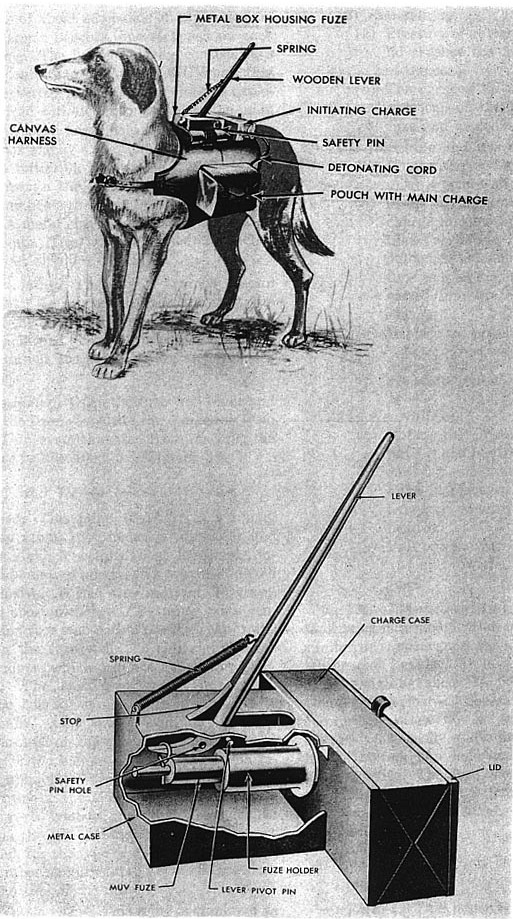 There were several reasons that these methods didn’t work. To drop the bomb, the dogs had to pull on a belt with his teeth to release it. This proved to be too complicated, and often the dog would simply return to its handler without releasing the bomb. Secondly, remotes were too expensive at the time to be used practically, so timers would be used more often instead. If the dog returned to his handler with the bomb still attached, he would have killed the handler and himself. Even if the bomb was released under the tank, if the tank was in motion and the timing wasn’t set just so, the bomb would simply explode without doing any damage to the enemy tank. The Soviets scrapped their initial plan, but unfortunately for Fido, they came up with a new one. Rather than drop a bomb, explosives would be strapped to the dog. When the dog went under the tank, the bomb would be triggered, killing the dog (and, hopefully, disabling the tank). As if ending their life wasn’t enough, the training involved wasn’t exactly a walk in the park. The dogs were starved, and then food was placed under a practice tank, training them to think that food was under all tanks. After a while, additional battle sounds were added to their practice runs so that they wouldn’t be spooked when they were running under the real thing. Anti-tank dogs started being used in earnest in 1941, when German forces advanced on Soviet lands. Thirty dogs kicked off what would be a rather lacklustre debut for the exploding dog-force; indeed, the dogs were so ineffective that the Soviet military was accused of simply sacrificing them. Part of the problem was that many of the dogs refused to dive under the tanks in the field. They were being shot at, which hadn’t happened in training, and they were understandably not willing to dive under some huge “beast” that was seemingly trying to kill them. Food can only motivate an animal so much. Whether they were useful or not, anti-tank dogs started to be used less and less from 1942 onwards, though there were anti-tank dogs that continued to be trained until 1996. While the Soviets were perhaps the most prominent users of anti-tank dogs, they were trained in other countries, too, including Japan and the United States. Much more recently, bombs were strapped to dogs as late as 2007 when insurgents attempted to use them during the Iraq War. In this case, there’s only one documented case of a bomb actually being detonated while attached to a dog though; protests rose up among Muslims who believe that animals should be killed only for food.
There were several reasons that these methods didn’t work. To drop the bomb, the dogs had to pull on a belt with his teeth to release it. This proved to be too complicated, and often the dog would simply return to its handler without releasing the bomb. Secondly, remotes were too expensive at the time to be used practically, so timers would be used more often instead. If the dog returned to his handler with the bomb still attached, he would have killed the handler and himself. Even if the bomb was released under the tank, if the tank was in motion and the timing wasn’t set just so, the bomb would simply explode without doing any damage to the enemy tank. The Soviets scrapped their initial plan, but unfortunately for Fido, they came up with a new one. Rather than drop a bomb, explosives would be strapped to the dog. When the dog went under the tank, the bomb would be triggered, killing the dog (and, hopefully, disabling the tank). As if ending their life wasn’t enough, the training involved wasn’t exactly a walk in the park. The dogs were starved, and then food was placed under a practice tank, training them to think that food was under all tanks. After a while, additional battle sounds were added to their practice runs so that they wouldn’t be spooked when they were running under the real thing. Anti-tank dogs started being used in earnest in 1941, when German forces advanced on Soviet lands. Thirty dogs kicked off what would be a rather lacklustre debut for the exploding dog-force; indeed, the dogs were so ineffective that the Soviet military was accused of simply sacrificing them. Part of the problem was that many of the dogs refused to dive under the tanks in the field. They were being shot at, which hadn’t happened in training, and they were understandably not willing to dive under some huge “beast” that was seemingly trying to kill them. Food can only motivate an animal so much. Whether they were useful or not, anti-tank dogs started to be used less and less from 1942 onwards, though there were anti-tank dogs that continued to be trained until 1996. While the Soviets were perhaps the most prominent users of anti-tank dogs, they were trained in other countries, too, including Japan and the United States. Much more recently, bombs were strapped to dogs as late as 2007 when insurgents attempted to use them during the Iraq War. In this case, there’s only one documented case of a bomb actually being detonated while attached to a dog though; protests rose up among Muslims who believe that animals should be killed only for food. -
10.
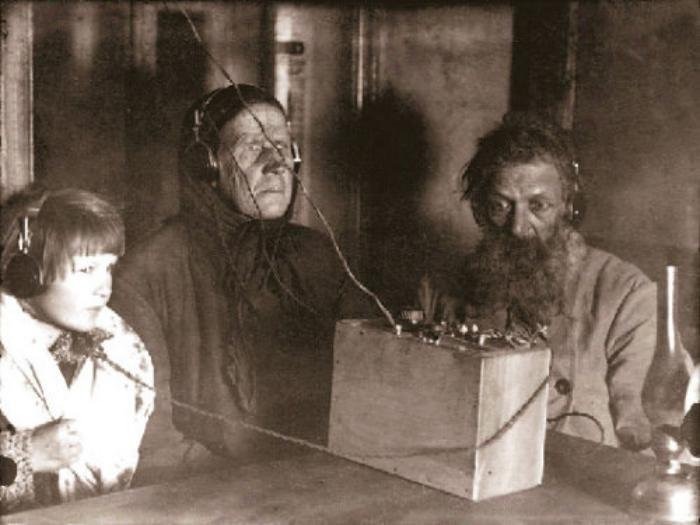 Family listens to an evening broadcast Soviet Union 1925
Family listens to an evening broadcast Soviet Union 1925 -
11.
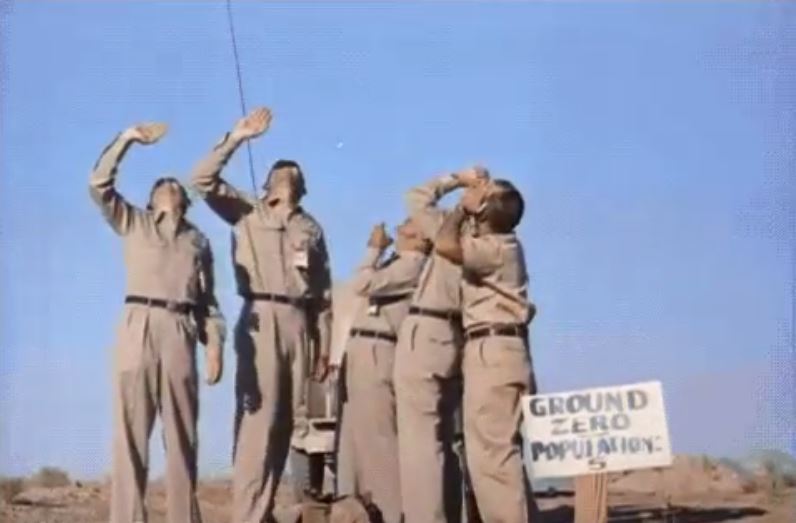 On July 19, 1957 five men stood at Ground Zero of atomic test in Nevada. The nuclear missile detonated 10,000 ft above their head.
On July 19, 1957 five men stood at Ground Zero of atomic test in Nevada. The nuclear missile detonated 10,000 ft above their head. -
12.
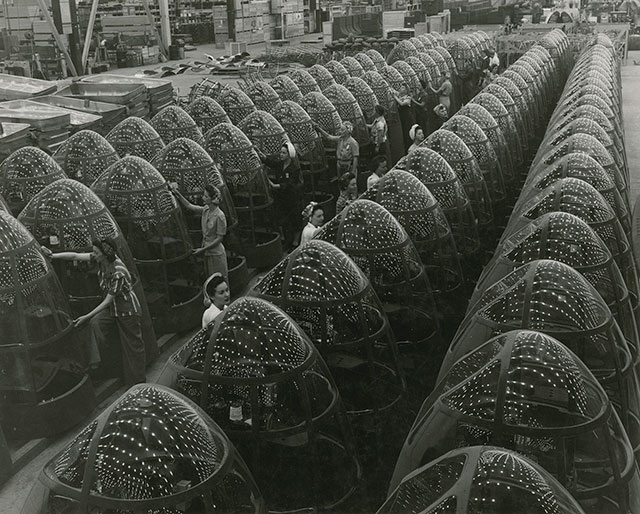 Women employees working on the nose assemblies of Douglas “Havoc” A-20 attack bombers. 1942. Factories like these are how the US was able to increase aircraft production from under 3,000/year in 1939 to almost 100,000/year in 1944. By war’s end the US had manufactured nearly 300,000 aircraft.
Women employees working on the nose assemblies of Douglas “Havoc” A-20 attack bombers. 1942. Factories like these are how the US was able to increase aircraft production from under 3,000/year in 1939 to almost 100,000/year in 1944. By war’s end the US had manufactured nearly 300,000 aircraft. -
13.
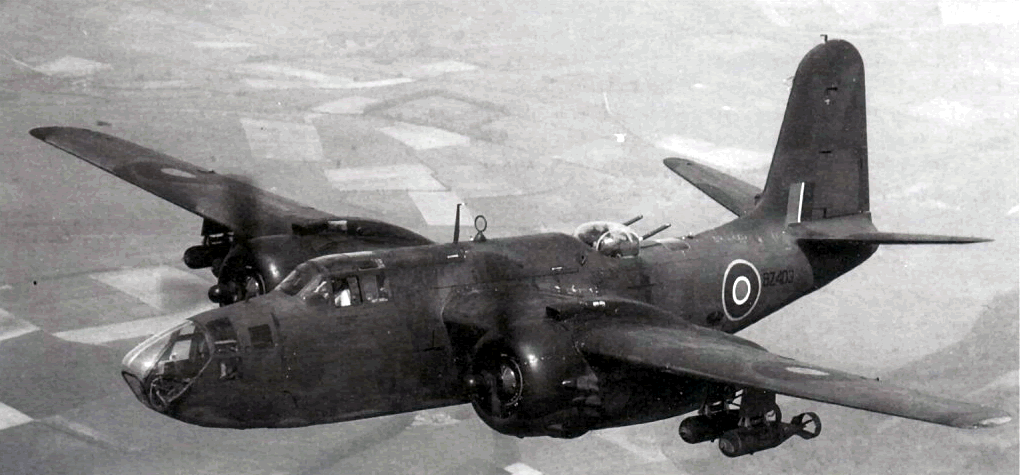 Douglas A-20 Havoc light attack bomber
Douglas A-20 Havoc light attack bomber -
14.
 Aerail view of residential district in Tokyo after firebombing, September 10, 1945
Aerail view of residential district in Tokyo after firebombing, September 10, 1945 -
15.
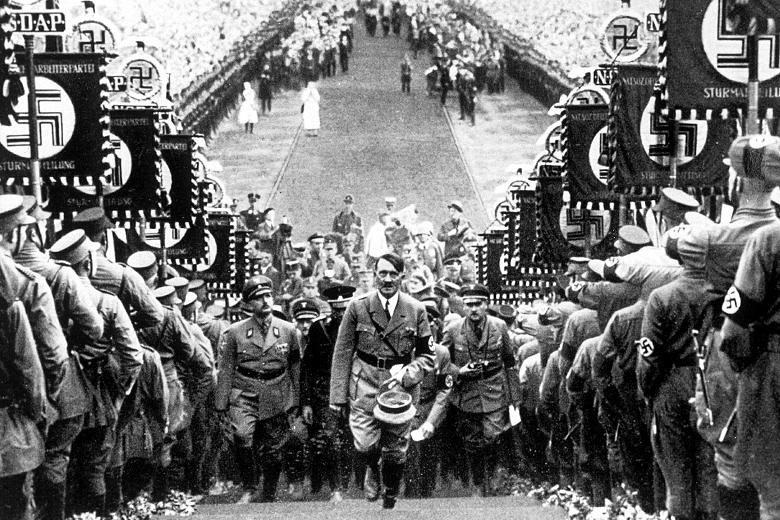 Hitler mounts the steps to the podium from where he will make his speech at the Nuremberg Rally, 1938
Hitler mounts the steps to the podium from where he will make his speech at the Nuremberg Rally, 1938 -
16.
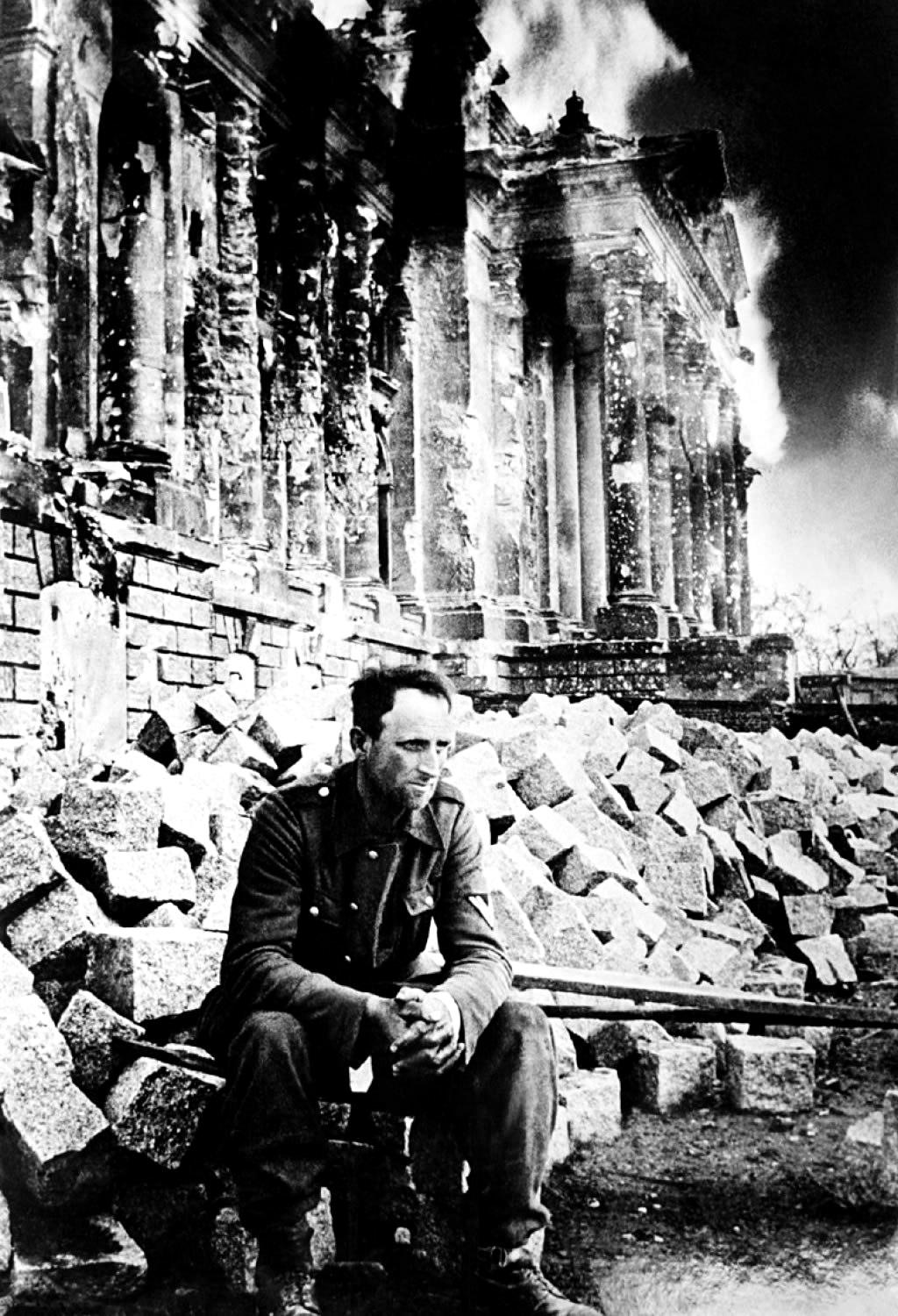 German soldier during the Battle of Berlin as the Reichstag burns behind him, April 1945
German soldier during the Battle of Berlin as the Reichstag burns behind him, April 1945 -
17.
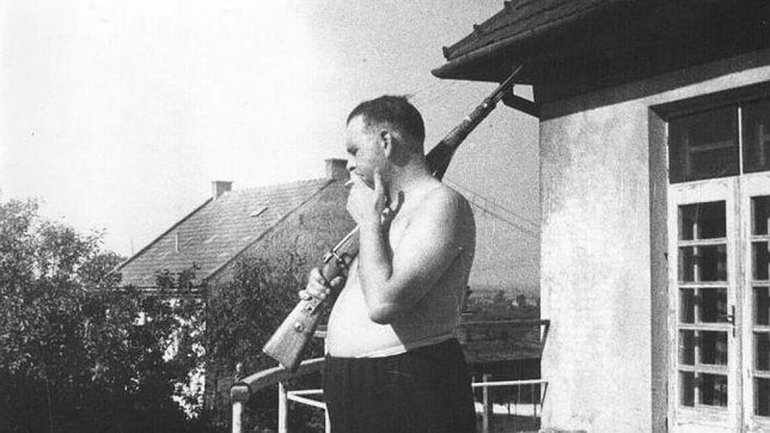 Camp Commandant Amon Goeth, infamous from the movie “Schindler’s List”, on the balcony of his house overlooking Plaszow labor camp. 1943-44 Amon Leopold Goeth the villain of the movie Schindler’s List, was born in 1908 in Vienna, Austria. At the age of 24, he joined the Nazi party. In 1940, Amon Goeth became a member of the Waffen-SS. He was assigned to the SS headquarters for Operation Reinhard in Lublin in German-occupied Poland in 1942. Operation Reinhard was the plan to evacuate the Jews from the Ghettos in Poland to three death camps: Treblinka, Sobibor and Belzec, all of which were in eastern Poland. In February 1943, Goeth received a promotion and became the third SS officer to hold the job of Commandant of the Plaszow labor camp. While he was the Commandant of Plaszow, Goeth was assigned to supervise the liquidation of the Podgorze ghetto on March 13, 1943, and later the labor camp at Szebnie. The liquidation of the Podgorze ghetto in Krakow is shown in the movie, Schindler’s List.
Camp Commandant Amon Goeth, infamous from the movie “Schindler’s List”, on the balcony of his house overlooking Plaszow labor camp. 1943-44 Amon Leopold Goeth the villain of the movie Schindler’s List, was born in 1908 in Vienna, Austria. At the age of 24, he joined the Nazi party. In 1940, Amon Goeth became a member of the Waffen-SS. He was assigned to the SS headquarters for Operation Reinhard in Lublin in German-occupied Poland in 1942. Operation Reinhard was the plan to evacuate the Jews from the Ghettos in Poland to three death camps: Treblinka, Sobibor and Belzec, all of which were in eastern Poland. In February 1943, Goeth received a promotion and became the third SS officer to hold the job of Commandant of the Plaszow labor camp. While he was the Commandant of Plaszow, Goeth was assigned to supervise the liquidation of the Podgorze ghetto on March 13, 1943, and later the labor camp at Szebnie. The liquidation of the Podgorze ghetto in Krakow is shown in the movie, Schindler’s List. -
18.
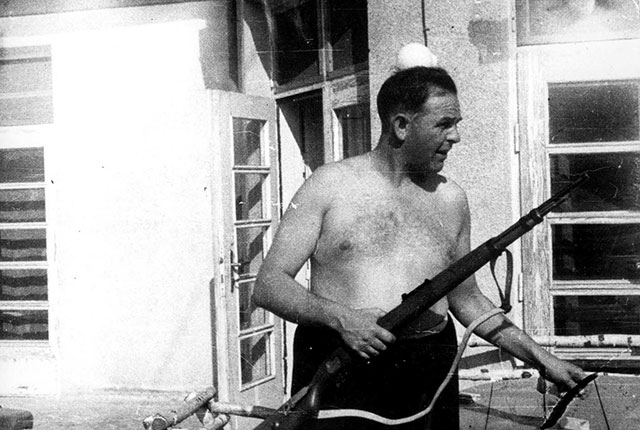 In early 1944 the status of the Kraków-Płaszów Labour Camp changed to a permanent concentration camp under the direct authority of the SS-Wirtschafts-Verwaltungshauptamt. It was during the earlier period that Goeth committed most of the random and brutal killings for which he became notorious. Concentration camps were more closely monitored by the SS than labor camps, so conditions improved slightly when the designation was changed. The camp housed about 2,000 inmates when it opened. At its peak of operations in 1944, a staff of 636 guards oversaw 25,000 permanent inmates, and an additional 150,000 people passed through the camp in its role as a transit camp. Goeth personally murdered prisoners on a daily basis. His two dogs, Rolf and Ralf, were trained to tear inmates to death. He shot people from the window of his office if they appeared to be moving too slowly or resting in the yard. He shot to death a Jewish cook because the soup was too hot. He brutally mistreated his two maids, Helen Jonas-Rosenzweig and Helen Hirsch, who were in constant fear for their lives, as were all the inmates. This is how prisoner Joseph Bau (Prisoner Number 69084) described Goeth: “A hideous and terrible monster who reached the height of more than two meters. He set the fear of death in people, terrified masses and accounted for much chattering of teeth. He ran the camp through extremes of cruelty that are beyond the comprehension of a compassionate mind – employing tortures which dispatched his victims to hell. For even the slightest infraction of the rules he would rain blow after blow upon the face of the helpless offender, and would observe with satisfaction born of sadism, how the cheek of his victim would swell and turn blue, how the teeth would fall out and the eyes would fill with tears. Anyone who was being whipped by him was forced to count in a loud voice, each stroke of the whip and if he made a mistake was forced to start counting over again. During interrogations, which were conducted in his office, he would set his dog on the accused, who was strung by his legs from a specially placed hook in the ceiling. In the event of an escape from the camp, he would order the entire group from which the escapee had come, to form a row, would give the order to count ten and would, personally kill every tenth person. At one morning parade, in the presence of all the prisoners he shot a Jew, because, as he complained, the man was too tall. Then as the man lay dying he urinated on him. Once he caught a boy who was sick with diarrhoea and was unable to restrain himself. Goeth forced him to eat all the excrement and then shot him”.
In early 1944 the status of the Kraków-Płaszów Labour Camp changed to a permanent concentration camp under the direct authority of the SS-Wirtschafts-Verwaltungshauptamt. It was during the earlier period that Goeth committed most of the random and brutal killings for which he became notorious. Concentration camps were more closely monitored by the SS than labor camps, so conditions improved slightly when the designation was changed. The camp housed about 2,000 inmates when it opened. At its peak of operations in 1944, a staff of 636 guards oversaw 25,000 permanent inmates, and an additional 150,000 people passed through the camp in its role as a transit camp. Goeth personally murdered prisoners on a daily basis. His two dogs, Rolf and Ralf, were trained to tear inmates to death. He shot people from the window of his office if they appeared to be moving too slowly or resting in the yard. He shot to death a Jewish cook because the soup was too hot. He brutally mistreated his two maids, Helen Jonas-Rosenzweig and Helen Hirsch, who were in constant fear for their lives, as were all the inmates. This is how prisoner Joseph Bau (Prisoner Number 69084) described Goeth: “A hideous and terrible monster who reached the height of more than two meters. He set the fear of death in people, terrified masses and accounted for much chattering of teeth. He ran the camp through extremes of cruelty that are beyond the comprehension of a compassionate mind – employing tortures which dispatched his victims to hell. For even the slightest infraction of the rules he would rain blow after blow upon the face of the helpless offender, and would observe with satisfaction born of sadism, how the cheek of his victim would swell and turn blue, how the teeth would fall out and the eyes would fill with tears. Anyone who was being whipped by him was forced to count in a loud voice, each stroke of the whip and if he made a mistake was forced to start counting over again. During interrogations, which were conducted in his office, he would set his dog on the accused, who was strung by his legs from a specially placed hook in the ceiling. In the event of an escape from the camp, he would order the entire group from which the escapee had come, to form a row, would give the order to count ten and would, personally kill every tenth person. At one morning parade, in the presence of all the prisoners he shot a Jew, because, as he complained, the man was too tall. Then as the man lay dying he urinated on him. Once he caught a boy who was sick with diarrhoea and was unable to restrain himself. Goeth forced him to eat all the excrement and then shot him”. -
19.
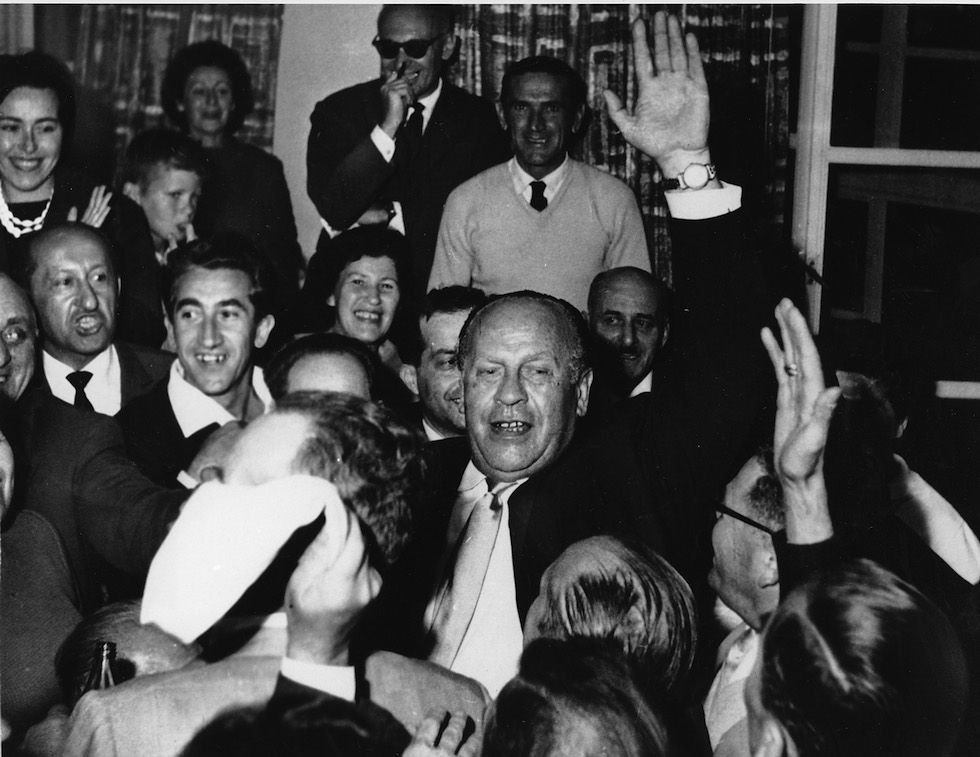 Oskar Schindler being greeted by 300 holocaust survivors in Jerusalem, on May 1, 1962
Oskar Schindler being greeted by 300 holocaust survivors in Jerusalem, on May 1, 1962
- REPLAY GALLERY
-

- 19 Fascinating Photos Collected From History
- NEXT GALLERY
-

- No Relevance Intended
H.H. Holmes The First Serial Killer Of America. Dr. Henry Howard Holmes was America’s first documented serial killer. As his famous controversial story goes, Holmes opened a hotel in Chicago which he design himself to situate his plans of murder. He has been proven guilty for almost 200 murders in the US. On his trial, he spoke out a chilling statement that goes: “I was born with the devil in me. I could not help the fact that I was a murderer, no more than the poet can help the inspiration to sing — I was born with the ‘Evil One’ standing as my sponsor beside the bed where I was ushered into the world, and he has been with me since.”
19/19
1/19
Categories:
Wow


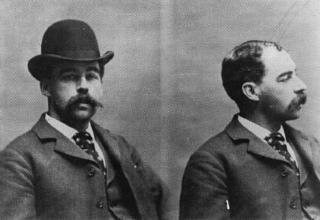

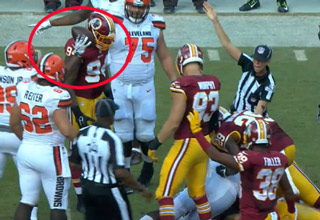


0 Comments